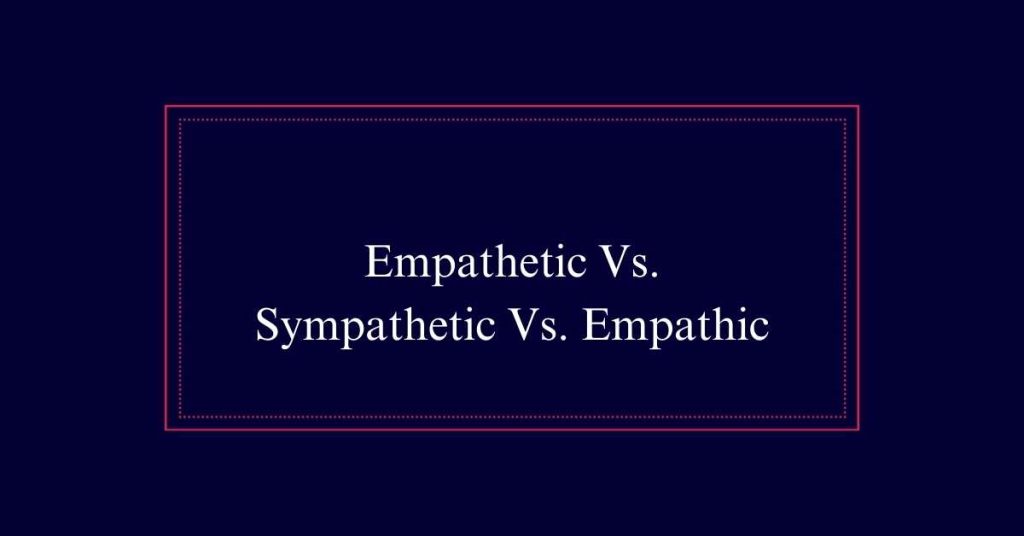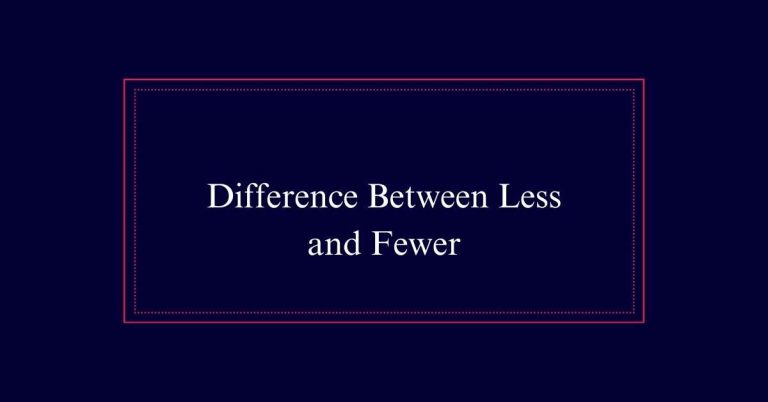Empathetic Vs. Sympathetic Vs. Empathic
Empathetic and empathic refer to the ability to deeply understand and share another person’s emotions. ‘Empathetic’ is more common in everyday usage, whereas ’empathic’ appears in scientific and niche contexts. Sympathy, on the other hand, involves feeling concern and compassion for another’s situation without necessarily sharing their emotional experience. Both empathy and sympathy are important for effective communication and relationships.
Understanding Empathetic
Understanding empathetic behavior involves recognizing the profound ability to deeply connect with and comprehend the emotions of others. This means truly perceiving what another person feels and experiencing it as if it were your own.
Being empathetic is not merely about feeling pity or sorrow; it’s about understanding the emotional state of another person. This ability enhances communication and strengthens interpersonal relationships. Empathetic individuals can offer support that is genuine and meaningful. They listen actively and respond in ways that reflect their understanding.
This quality is essential in both personal and professional contexts, fostering trust and connection. Developing empathy can lead to more compassionate interactions and a more harmonious environment.
Defining Empathy
Empathy, at its core, is the ability to feel and understand the emotional experiences of others as if they were one’s own. This involves not just recognizing another person’s emotional state but also sharing in it. Empathy requires a deep level of emotional intelligence, allowing individuals to connect on a profound level.
It goes beyond mere sympathy, which is simply feeling pity or sorrow for someone else’s misfortune. Empathy entails an immersive experience where one truly grasps what another person is feeling. It is an essential skill in both personal and professional relationships. By fostering empathy, individuals can build stronger, more meaningful connections and communicate more effectively.
Synonyms of Empathetic
While empathetic is a widely used term, several synonyms capture its essence effectively. Compassionate is one such synonym, highlighting a deep concern for others’ suffering.
Understanding also aligns closely, indicating a keen awareness of others’ emotions.
Commiserative implies sharing in someone else’s sorrow or hardship.
Sympathetic, though slightly different in nuance, similarly conveys a sense of care and concern.
These words, while varied in their subtle distinctions, all embody the core principle of empathy—an ability to connect with and understand the emotions of others.
Employing these synonyms can enrich communication, ensuring that the depth of one’s empathetic capacity is fully conveyed.
Empathetic Vs. Empathic
Although synonyms like compassionate and understanding enrich our vocabulary, it’s important to distinguish between empathetic and empathic. While both terms describe a deep understanding of others’ emotions, they have subtle differences in usage:
- Historical Usage: Empathic is the older term, originating in 1909, while empathetic was first recorded in 1932.
- Contextual Preference: In scientific writing, empathic is more frequently used, whereas empathetic is common in everyday language.
- Cultural Associations: Empathic is often linked with New Age concepts and the idea of an ’empath,’ a person highly sensitive to others’ emotions.
- Interchangeability: Despite these differences, empathetic and empathic are generally interchangeable in most contexts.

Historical Context
Tracing the historical context of empathetic and empathic reveals interesting insights into their evolution and usage. The term ’empathic’ appeared first in 1909, grounded in psychological studies. It was used to describe a deep understanding of another’s emotional state.
“Empathetic” came later, first recorded in 1932, and has since become more common in general usage.
Over time, both terms have been used interchangeably, although ’empathic’ often appears in scientific literature. The evolution of these terms reflects broader societal shifts towards valuing emotional intelligence and interpersonal understanding.
While ’empathetic’ is more prevalent in everyday language, ’empathic’ retains a niche usage, particularly in specialized fields and New Age contexts.
The scientific exploration of empathy has revealed its profound impact on human behavior and psychological well-being. Researchers have discovered that empathy plays a pivotal role in social interactions and mental health.
Key scientific findings include:
- Enhanced Social Bonds: Empathy strengthens relationships by fostering mutual understanding and trust.
- Improved Mental Health: Empathetic interactions can reduce stress and anxiety, promoting overall mental well-being.
- Conflict Resolution: Understanding others’ perspectives helps in resolving conflicts more effectively.
- Pro-Social Behavior: Empathy encourages acts of kindness and cooperation within communities.
Comparing Empathetic and Sympathetic
Shifting focus from empathic abilities in New Age teachings, it’s important to distinguish between being empathetic and sympathetic. Empathy involves deeply understanding another’s emotions by putting oneself in their shoes.
Sympathy, however, is about feeling concern and care for someone’s struggles without experiencing their emotions firsthand.
Key differences include:
- Depth of Connection: Empathy involves a deeper emotional connection.
- Emotional Experience: Empathetic people feel what others feel; sympathetic people do not.
- Action vs. Understanding: Sympathy often leads to supportive gestures, while empathy fosters genuine understanding.
- Contextual Use: Empathy is essential in personal relationships; sympathy is often seen in broader social interactions.
Both qualities are essential but serve different purposes in human interactions.
Role of Sympathy
Understanding the role of sympathy reveals its significance in offering comfort and support during difficult times. Sympathy involves recognizing someone’s distress and expressing concern. It is an essential human response to others’ suffering and can help alleviate feelings of isolation.
By showing sympathy, we acknowledge another’s hardship, which can provide emotional relief and a sense of being cared for. This can be vital in both personal relationships and professional settings, such as healthcare or counseling.
Sympathy does not require experiencing the same emotions as the other person but involves a sincere gesture of care. Ultimately, sympathy serves as a bridge to emotional connection, fostering a supportive environment where individuals feel valued and understood.
Building Empathy Skills
Cultivating empathy skills involves actively listening to others and trying to understand their perspectives. This process requires consistent effort and practice.
Here are four effective ways to build empathy skills:
- Active Listening: Pay full attention to the speaker, and show that you are engaged through nonverbal cues like nodding and maintaining eye contact.
- Ask Open-Ended Questions: Encourage others to express themselves more fully by asking questions that require more than a yes or no answer.
- Reflect and Paraphrase: Repeat back what you have heard in your own words to confirm understanding and show that you are listening.
- Practice Perspective-Taking: Try to imagine yourself in the other person’s situation to better understand their feelings and motivations.






